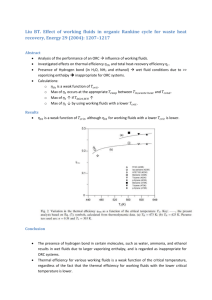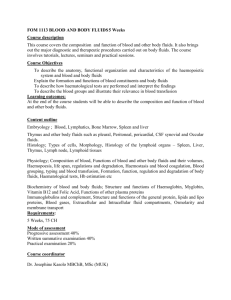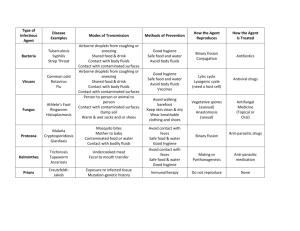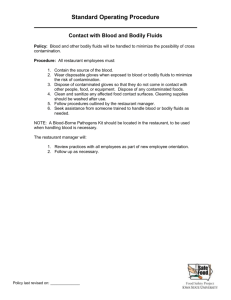Přírůstkové číslo *
advertisement
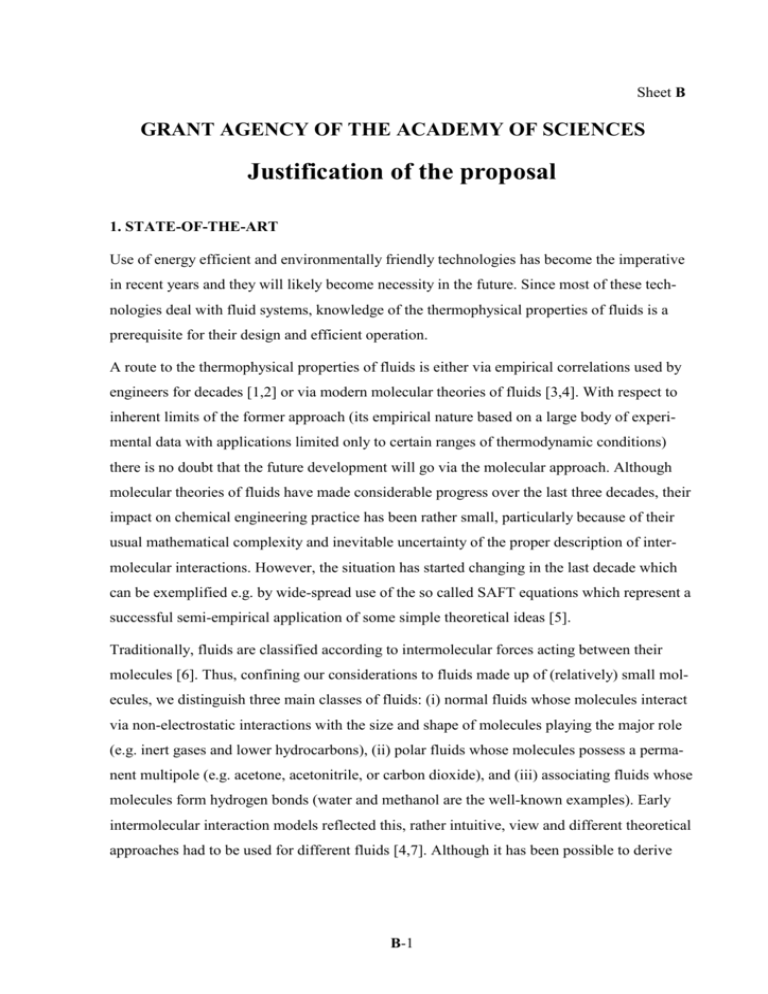
Sheet B GRANT AGENCY OF THE ACADEMY OF SCIENCES Justification of the proposal 1. STATE-OF-THE-ART Use of energy efficient and environmentally friendly technologies has become the imperative in recent years and they will likely become necessity in the future. Since most of these technologies deal with fluid systems, knowledge of the thermophysical properties of fluids is a prerequisite for their design and efficient operation. A route to the thermophysical properties of fluids is either via empirical correlations used by engineers for decades [1,2] or via modern molecular theories of fluids [3,4]. With respect to inherent limits of the former approach (its empirical nature based on a large body of experimental data with applications limited only to certain ranges of thermodynamic conditions) there is no doubt that the future development will go via the molecular approach. Although molecular theories of fluids have made considerable progress over the last three decades, their impact on chemical engineering practice has been rather small, particularly because of their usual mathematical complexity and inevitable uncertainty of the proper description of intermolecular interactions. However, the situation has started changing in the last decade which can be exemplified e.g. by wide-spread use of the so called SAFT equations which represent a successful semi-empirical application of some simple theoretical ideas [5]. Traditionally, fluids are classified according to intermolecular forces acting between their molecules [6]. Thus, confining our considerations to fluids made up of (relatively) small molecules, we distinguish three main classes of fluids: (i) normal fluids whose molecules interact via non-electrostatic interactions with the size and shape of molecules playing the major role (e.g. inert gases and lower hydrocarbons), (ii) polar fluids whose molecules possess a permanent multipole (e.g. acetone, acetonitrile, or carbon dioxide), and (iii) associating fluids whose molecules form hydrogen bonds (water and methanol are the well-known examples). Early intermolecular interaction models reflected this, rather intuitive, view and different theoretical approaches had to be used for different fluids [4,7]. Although it has been possible to derive B-1 molecular-based equations of state [7], diversity of the functional forms of the potential models, and hence of the derived equations, has made it difficult (or even practically impossible) to extend this approach, in general, to mixtures. With development of computer technology, quantum chemical computation methods have also made considerable progress resulting in development of reasonably accurate effective pair potentials in a uniform form. Molecules are viewed as bodies made up of individual atoms or groups of atoms and realistic intermolecular potential models are then written as a sum of interactions between these atoms or groups. Thus, regardless of the observed properties and their possible peculiarities, modern intermolecular potential functions have the form of sitesite models with neutral interactions (typically Lennard-Jones) and/or point-charge electrostatic interactions [8,9]. Since such potentials cannot be decomposed into individual physically meaningful contributions (e.g. dipole-dipole interaction, hydrogen bonding interaction, etc.), theoretical investigations have focused on the effect of the range of interactions on the properties of fluids [10-12]. It has been firmly established that the properties of fluids are determined primarily by shortrange interactions which may be both repulsive and attractive. Specifically, it has been found that the structure of realistic fluids and their short-range counterparts, described by the set of the site-site correlation functions, is very similar (nearly identical) and, as a consequence of this finding, the thermodynamic properties of realistic fluids are very well estimated by those of the short-range models; the internal energy of the short-range models accounts for at least 95% of the total internal energy of the full realistic fluids. All these findings are important from the theoretical point of view because they open the possibility of developing a fast converging perturbation expansion about a short-range reference with the long-range Coulombic interactions treated as a perturbation only [13]. In order to accomplish the perturbation expansion, the properties of the reference must be known, preferably in an analytic form. However, the short-range reference system defined by a parent realistic full potential is too complex to be amenable to a direct theoretical description. Therefore, following the pattern established for simple fluids, the short-range reference is further simplified and a simple (so called primitive) model is constructed by means of which the properties of the reference are estimated (cf. implementation of a perturbation expansion for simple fluids by approximating the properties of a short-range soft-repulsive system by B-2 those of the fluid of hard spheres [3]). Such primitive models have already been developed for water [14,15] and applied not only for developing an equation of state, but also directly to explain the properties of aqueous solutions [16,17]. The feasibility of the entire perturbation expansion scheme has then been demonstrated recently by deriving an accurate molecularbased equation of state for water [18]. For other fluids the development along the above outlined route is at the very beginning and is the subject of this project. 2. MAIN GOALS, DETAILS OF THE METHODS USED, AND TIMING The proposed project represents a natural continuation of previous studies (funded also by the Grant Agency of the Academy of Sciences) in which the effect of the long-range interactions was investigated in detail, and in which primitive models of water were developed. The results of these studies, summarized in two review papers [19,20], justify attempts to develop a fully molecular theory of fluids and derive workable equations for their thermodynamic properties in a uniform way. To develop such a theory and equations, and apply them to selected mixtures of industrial interest is the main goal of the proposed project. Its individual steps are as follows: 1. We will start from realistic (preferably transferable) effective pair potentials for alcohols, selected polar fluids, and carbon dioxide, define their associated short-range counterparts which should form a reference in the perturbation expansion, and investigate them by computer simulations. 2. Primitive models will be constructed to the short-range models descending from the realistic potentials and investigated both theoretically and by means of computer simulations. It must be verified that the developed primitive models do reproduce reasonably well the properties of the realistic short-range reference systems. This is the crucial point of the method. 3. Provided that the two previous steps are successful, an attempt should be made to simplify the theoretical results into a form which could be acceptable in equations of state for engineers for practical applications. 4. Perturbation expansion will be completed and equations of state will be formulated, tested, and applied to the selected dipolar, quadrupolar, and associating fluids; the same functional form will also be used for hydrocarbons. Thermodynamic conditions should cover as large B-3 range as possible, but a special attention will be paid to the region in vicinity of the critical points of water and carbon dioxide. 5. Extensive investigation of (binary and ternary) mixtures described by the derived equations will be conducted and the entire approach thoroughly assessed. The first two items of the above list will likely take up first two years. Attempts to solve item three will start during the second year and continue in the third year. The third year should also be devoted to developing and testing of complete equations of state for selected real compounds. The last stage, examination of mixtures and assessment of the used method, is planned for the fourth year. References: [1] Poling, B. E., O’Connell, J. P.: The Properties of Gases and Liquids. New York, McGraw-Hill (2001). [2] Chao, K. C., Robinson, R. L., Eds.: Equations of State. Theories and Applications. ACS Symposium Series. Washington, D.C., Am. Chem. Soc. (1986). [3] Hansen, J. P., McDonald, I. R.: Theory of Simple Liquids. New York, Academic (1986). [4] Gray, C. G., Gubbins, K. E.: Theory of Molecular Fluids. Oxford, Clarendon Press (1984). [5] Muller, E. A., Gubbins, K. E.: “Molecular-based equations of state: A review of SAFT and related approaches.” Ind. Eng. Chem. Res. 40, 2193-2211 (2001). [6] Rowlinson, J. S., Swinton, F. L.: Liquids and Liquid Mixtures. London, Butterworths (1982). [7] Sengers, J. V., Kayser, R. F., Peters, C. J., White, H. J., Eds.: Equations of State for Fluids and Fluid Mixtures. Amsterdam, Elsevier (2000). [8] Jorgensen, W. L.: “Transferable intermolecular potential functions for water, alcohols, and ethers. Application to liquid water.” J. Am. Chem. Soc. 103, 335 (1981). [9] Jorgensen, W. L., Tirado-Rives, J.: “Development of the OPLS-AA force field for organic and biomolecular systems.” Abstracts of Papers of the American Chemical Society 216, 043-COMP (1998). B-4 [10] Nezbeda, I., Kolafa, J.: “Effect of short- and long-range forces on the structure of water: temperature and density dependence.” Mol. Phys. 97, 1105-1116 (1999). [11] Kolafa, J., Nezbeda, I.: “Effect of short- and long-range forces on the structure of water. II. Orientational ordering and the dielectric constant.” Mol. Phys. 98, 15051520 (2000). [12] Kolafa, J., Nezbeda, I., Lísal, M.: “Effect of short- and long-range forces on the properties of fluids. III. Dipolar and quadrupolar fluids.” Mol. Phys. 99, 1751-1764 (2001). [13] Nezbeda, I., Lísal, M.: “Effect of short and long range forces on the thermodynamic properties of water. A simple short range reference system.” Mol. Phys. 99, 291300 (2001). [14] Nezbeda, I., Slovák, J.: “A family of primitive models of water: three- four-, and five-site models.” Mol. Phys. 90, 353-372 (1997). [15] Slovák, J., Nezbeda, I.: “Extended 5-site primitive models of water: theory and computer simulations.” Mol. Phys. 91, 1125-1136 (1997). [16] Nezbeda, I.: “Solubility of apolar fluids in water: A simple molecular model and theory.” Fluid Phase Equil. 170, 13-22 (2000). [17] Předota, M., Nezbeda, I.: “Hydrophobic hydration at the level of primitive models.” Mol. Phys. 96, 1237-1248 (1999). [18] Nezbeda, I., Weingerl, U.: “A molecular-based theory for the thermodynamic properties of water.” Mol. Phys. 99, 1595-1606 (2001). [19] Nezbeda I.: “Simple short-ranged models of water and their application. A review.” J. Mol. Liquids, 73/74, 317-336 (1997). [20] Nezbeda I.: “Towards a uniform view of fluids.” Mol. Phys., in press. 3. RESEARCH TEAM, INTERNATIONAL COOPERATION, AND EQUIPMENT The ability of the research team to accomplish the project stems from its many-year experience and expertise in the field of molecular physics of fluids. The principal investigator is the well-known top scientist (cf. Annual Citation Index). He and Dr. Kolafa were the first who B-5 studied in detail the effect of the long-range interactions on the properties of fluids and ones of those who introduced and have pushed forward the new approach to associating fluids based on models without long-ranged forces. Dr. Lisal participated in applications of the concept of the short-range models to real water and Dr. Slovak published several papers on applications of the thermodynamic perturbation theory to the primitive models. Dr. Předota has gained during his 3 year stay as a post-doctoral fellow at the Department of Chemical Engineering, University of Tennessee, considerable experience with realistic interaction models, and with dealing with and modeling real systems. Finally, Dr. Pavlicek was involved in a first attempt to derive an equation of state of water using the primitive model as a reference, and Dr. Aim is the well-known experimentalist and chemical engineer who will contribute to the application part dealing with real solutions. The application part of the project will be carried out in a close collaboration with Professor W. R. Smith, University of Guelph, Ontario, whose expertise in the chemical engineering of solutions will help to target the problems of industrial importance. Close contacts with the group of Professor P. T. Cummings of the University of Tennessee in Knoxville have been established and the collaboration with this group will also proceed along the lines outlined in this proposal. To reach the goals of the project, it will be necessary to perform, in addition to analytical and routine numerical calculations, a large number of computer simulations. The available computing facilities of the group (five PC’s, one workstation, and the core of a PC cluster) seem nearly sufficient for this purpose and no new large investments are therefore demanded. However, to keep up with increasing computing time demands resulting from increasing complexity of the solved problems, systematic gradual upgrading of the available PC's (faster processor, larger memory, larger hard disk) will be necessary. B-6

